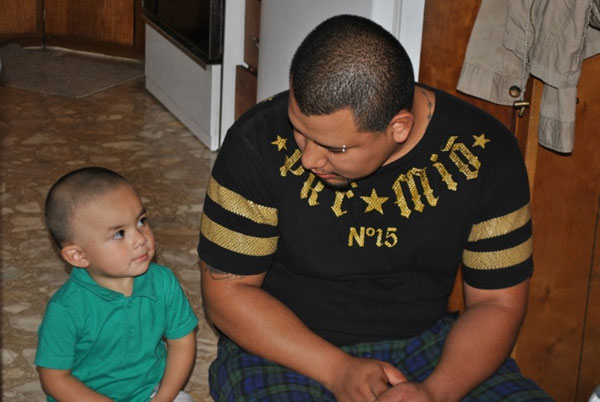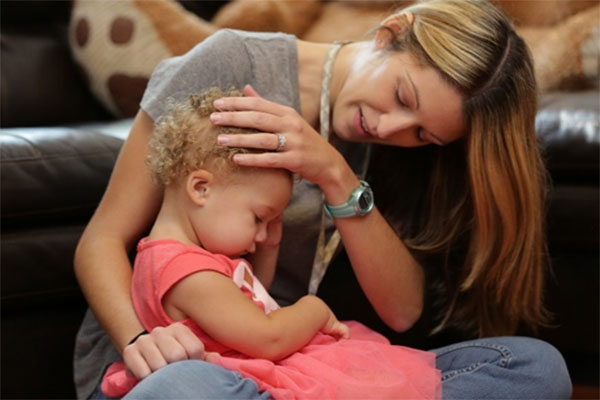Secure Relationships
Chapter 6a: Secure Relationships Experience It
Narrator: In New York City, Berkis Rodriguez and Miriam Prieto team for home visits to Nathalie and her parents, Patricia and Elvis.
[Music]
This morning, the team is on the way to visit 11-month-old Nathalie and her mother, Patricia. Home visits are conducted in either English or Spanish, depending on the preference of the family. Berkis: The community's basically a Latino-speaking community. They come from different part of the country, but most of them speak Spanish. They have a large population of Dominican, but also Mexican. You can find some Salvadorian and Ecuadorian; so it's mix.
Miriam: Berkis and I are a team, because we work together, as a team. We basically do everything together.
Berkis: This is a big city and a lot of things happen. And it's more beneficial for the child, because, I might see something that she doesn't see and vice versa. So, I think it's done for safety reason but, also to have four eye instead of two.
Miriam: Hi, Nathalie.
Narrator: Berkis and Miriam have worked together to support Patricia through many challenges, since Nathalie's premature birth.
Patricia: She starts out; she starts turning. And that's how she'll get here.
Berkis: I remember the other day she was going around like that.
Patricia: Now she's turning side and side, and she pushes herself that way. Come on. Come on.
Berkis: I think it's very beneficial for Nathalie to get home visit, because it's a chance to do work in an environment that both of them feel comfortable in.
Patricia: You can make it. Come on. There you go. You almost got it. One more. Yay! Yay!
Berkis: Like you remember, last week in class, when she was going around in circles?
Patricia: Yeah.
Berkis: And that's kind of the way that she moved last week.
Patricia: Now, she's learning how to move sideways. She rocks sideways to reach something out of her grasp.
Berkis: I remember when we came one day and you said that she was rolling and she's keeping more focus. Like, she would give up more easily before.
Patricia: I was 27 weeks pregnant when I had her. She was one pound, 13 ounces when she was born. She stayed in the hospital for three months. She was born February. She was let go in May. Dada dada.
[Baby babbling]
Dadada.
Miriam: Have you been practicing floor time at home? With premature children, it's very, very rough road. It's like, you got to take -- learn how to take it one day at a time.
Berkis: This is the first premature child that I have ever worked with. I've been doing some reading sort of to get knowledge about what is expected what is the next stage -- step that Nathalie's going to be doing, and basically, I just meet Nathalie at the level where she's at and try to take it from there.
Patricia: She's doing this.
Berkis: She is?
Patricia: She's counting fingers to make sure all of them are there. It's like one, two, three. That's one thing with Berkis, she's always planning new things for Nathalie. I'm like, "Berkis, I'm not sure she can do it." She's like, "Yeah, yeah. She could do it. Let's do it." That's the way she helps me, because, I'm really afraid of trying new things for her. She gives me confidence to go, okay, let's go ahead, let's do it. She'll be okay. And she's -- I trust her. If Berkis says we could try it, I'm like, let's try it.
Narrator: The relationship Patricia has built with Berkis and Miriam inspires her to consider new possibilities for her daughter. Together, they set goals to build on Nathalie's emerging skills. The weekly socialization reinforces the work they do on home visits.
Berkis: Who's that? Who's that over there? Who's that girl? We try to put the rattle a little farther, and when she mastered that, we will do something else. But right now, we're focusing on having Nathalie reach the rattle and sort of work her way towards the rattle. So, it's intentionally that we do it at home, and we do it here.
Patricia: Little by little, yeah, they've been helping me recognize, and helping me, like, understand everything she's doing. And whatever she's doing, they, like, help me to better it. Like, if she's starting to rock, I'm like, okay, put a toy out of her reach, so she can learn how to rock and reach for it and learn how to reach for something.
[Elvis and Nathalie Speaking Spanish]
Narrator: Nathalie's father, Elvis, participates in weekly socializations that support her development, as well as, provide social time with other children and parents.
[Singing]
Patricia: It's a great thing. It's the best that could happen, even starting them off so small. Some people say, "Oh, what they going to do? They're just babies. They don't even sit." I'm like, they do a lot and they learn a lot.
Berkis: I feel fortunate that I have the opportunity to have such an input in the family's life. I feel a great responsibility doing it. That's why, every day, I want to do it the best I can.
Chapter 6a: Secure Relationships Experience It
Narrator: In New York City, Berkis Rodriguez and Miriam Prieto team for home visits to Nathalie and her parents, Patricia and Elvis.
[Music]
This morning, the team is on the way to visit 11-month-old Nathalie and her mother, Patricia. Home visits are conducted in either English or Spanish, depending on the preference of the family. Berkis: The community's basically a Latino-speaking community. They come from different part of the country, but most of them speak Spanish. They have a large population of Dominican, but also Mexican. You can find some Salvadorian and Ecuadorian; so it's mix.
Miriam: Berkis and I are a team, because we work together, as a team. We basically do everything together.
Berkis: This is a big city and a lot of things happen. And it's more beneficial for the child, because, I might see something that she doesn't see and vice versa. So, I think it's done for safety reason but, also to have four eye instead of two.
Miriam: Hi, Nathalie.
Narrator: Berkis and Miriam have worked together to support Patricia through many challenges, since Nathalie's premature birth.
Patricia: She starts out; she starts turning. And that's how she'll get here.
Berkis: I remember the other day she was going around like that.
Patricia: Now she's turning side and side, and she pushes herself that way. Come on. Come on.
Berkis: I think it's very beneficial for Nathalie to get home visit, because it's a chance to do work in an environment that both of them feel comfortable in.
Patricia: You can make it. Come on. There you go. You almost got it. One more. Yay! Yay!
Berkis: Like you remember, last week in class, when she was going around in circles?
Patricia: Yeah.
Berkis: And that's kind of the way that she moved last week.
Patricia: Now, she's learning how to move sideways. She rocks sideways to reach something out of her grasp.
Berkis: I remember when we came one day and you said that she was rolling and she's keeping more focus. Like, she would give up more easily before.
Patricia: I was 27 weeks pregnant when I had her. She was one pound, 13 ounces when she was born. She stayed in the hospital for three months. She was born February. She was let go in May. Dada dada.
[Baby babbling]
Dadada.
Miriam: Have you been practicing floor time at home? With premature children, it's very, very rough road. It's like, you got to take -- learn how to take it one day at a time.
Berkis: This is the first premature child that I have ever worked with. I've been doing some reading sort of to get knowledge about what is expected what is the next stage -- step that Nathalie's going to be doing, and basically, I just meet Nathalie at the level where she's at and try to take it from there.
Patricia: She's doing this.
Berkis: She is?
Patricia: She's counting fingers to make sure all of them are there. It's like one, two, three. That's one thing with Berkis, she's always planning new things for Nathalie. I'm like, "Berkis, I'm not sure she can do it." She's like, "Yeah, yeah. She could do it. Let's do it." That's the way she helps me, because, I'm really afraid of trying new things for her. She gives me confidence to go, okay, let's go ahead, let's do it. She'll be okay. And she's -- I trust her. If Berkis says we could try it, I'm like, let's try it.
Narrator: The relationship Patricia has built with Berkis and Miriam inspires her to consider new possibilities for her daughter. Together, they set goals to build on Nathalie's emerging skills. The weekly socialization reinforces the work they do on home visits.
Berkis: Who's that? Who's that over there? Who's that girl? We try to put the rattle a little farther, and when she mastered that, we will do something else. But right now, we're focusing on having Nathalie reach the rattle and sort of work her way towards the rattle. So, it's intentionally that we do it at home, and we do it here.
Patricia: Little by little, yeah, they've been helping me recognize, and helping me, like, understand everything she's doing. And whatever she's doing, they, like, help me to better it. Like, if she's starting to rock, I'm like, okay, put a toy out of her reach, so she can learn how to rock and reach for it and learn how to reach for something.
[Elvis and Nathalie Speaking Spanish]
Narrator: Nathalie's father, Elvis, participates in weekly socializations that support her development, as well as, provide social time with other children and parents.
[Singing]
Patricia: It's a great thing. It's the best that could happen, even starting them off so small. Some people say, "Oh, what they going to do? They're just babies. They don't even sit." I'm like, they do a lot and they learn a lot.
Berkis: I feel fortunate that I have the opportunity to have such an input in the family's life. I feel a great responsibility doing it. That's why, every day, I want to do it the best I can.
Reflections
What do you observe?
Answers may include:
- Home visitors talking about their program's policies
- Home visitors talking with the mother
- Mother shaking a rattle Nathalie, smiling, and laughing
- Nathalie attending to the rattle and reaching for it
- Home visitors and mother talking about their relationship and what their work together has done for Nathalie
- Nathalie sitting in the infant seat and her parents singing at group socialization
- Nathalie and both of her parents playing at the group socialization
What do the home visitors do to support a secure parent-child relationship?
Answers may include:
- Encourage parents to help the baby develop new skills, which engages parents in positive interactions with her
- Offer home visits and group socializations in the family's home language with bilingual/bicultural home visitors so they will feel their culture and language are important and supported in raising their child
- Enhance parents' confidence in Nathalie's development, encouraging the progress of their attachment, which could have been hindered by Nathalie's premature birth
- Encourage parents' enjoyment of Nathalie by engaging in shared positive interactions, such as playing, reading, and singing
How might the home visitors continue to reinforce a secure parent-child relationship?
Answers may include:
- By encouraging the family to continue to participate in group socializations so they can interact with other children and adults, sharing fun and social times together
- By encouraging the parents to hold Nathalie and engage in face-to-face activities, such as reciprocal communication and games like peek-a-boo and patty-cake
- By supporting the parents in using everyday experiences (e.g., diapering, feeding, etc.) to spend more time talking with Nathalie and giving her opportunities to develop her social and emotional skills
How would brief interactions like this one, repeated over time, develop a sense of security in a child?
Answers may include:
- By increasing parents' confidence that Nathalie's prematurity will not limit her potential and that it will enhance their attachment through shared successes
- By enhancing Nathalie's experience of closeness with her parents through shared pleasure and positive interaction
- By supporting Nathalie and her parents in valuing their shared language and culture
In which developmental domains do you observe Nathalie and her family engaged?
Answers may include:
- Perceptual, Motor, and Physical Development
- Rolling from back to front and from front to back
- Grasping the rattle and the book with one hand and with two hands
- Sitting with support
- Pushing herself up and holding her chest off the ground
- Social and Emotional Development
- Nathalie smiles several times—when the home visitor comes in, when her mother talks to her, at the rattle, and when the group is singing to her
- Nathalie and her mother babble back and forth to each other
- Nathalie's mother kisses her
- Cognition and General Knowledge
- Reaches for toy and grasps it
- Uses hand-eye coordination to reach for rattle and books
- Tries to get toys out of reach
- Uses problem-solving in turning over to reach the rattle
- Shows initiative in trying to reach toys
- Approaches to Learning
- Focuses on toys
- Persists in turning over to reach the rattle
- Pays attention when father shows her the book
- Language and Literacy
- Focuses on book
- Shows interest when mother squeaks book
- Babbles
- Singing in Spanish
Learn More
Parent, Family, and Community Engagement Simulation: Boosting School Readiness through Effective Family Engagement Series
A strong relationship between families and Head Start staff is essential to promoting healthy child development and positive learning outcomes. Strong relationships are rooted in trust and comfort, which you can build by being genuine, sincere, and curious about them and their goals, and by supporting them as they work toward those goals. There are a number of communication techniques you can use to build relationships with families. While these techniques are especially relevant to the first visit with a family, they can be applied to all interactions with families.
Parent Training Modules: Parents Interacting with Infants
This Center on the Social and Emotional Foundations for Early Learning (CSEFEL) module focuses on promoting the social and emotional development of infants and toddlers through the use of parent-child groups. It is based on the Parents Interacting with Infants (PIWI) model, but includes both infants and toddlers. PIWI has been successfully used in community-based and early intervention programs with a wide range of parents and children. While the primary focus of the module is parent-child groups, it also discusses how the model applies to home visiting.


 Throughout the first five years of life, children draw on a secure relationship with their parents as they learn and develop in every way. Older children, while involved in a wider variety of experiences, still draw on the security of their relationships with their parents to develop confidence in meeting new people and situations. This sense of security develops when adults are able to pay attention to the child's actions and interests and accurately identify the child's needs. Additionally, the adult is able to respond to those needs effectively, and both adult and child experience the overall interaction as essentially pleasurable and mutual.
Throughout the first five years of life, children draw on a secure relationship with their parents as they learn and develop in every way. Older children, while involved in a wider variety of experiences, still draw on the security of their relationships with their parents to develop confidence in meeting new people and situations. This sense of security develops when adults are able to pay attention to the child's actions and interests and accurately identify the child's needs. Additionally, the adult is able to respond to those needs effectively, and both adult and child experience the overall interaction as essentially pleasurable and mutual. In the first three years, children learn their culture's and family's rules for how to participate in relationships, what behaviors are unacceptable, and how their families expect them to learn. Over the next years, they will continue to learn their roles, relationships with those who are older or younger, and other culturally rooted ways of thinking, learning, and living.
In the first three years, children learn their culture's and family's rules for how to participate in relationships, what behaviors are unacceptable, and how their families expect them to learn. Over the next years, they will continue to learn their roles, relationships with those who are older or younger, and other culturally rooted ways of thinking, learning, and living. 